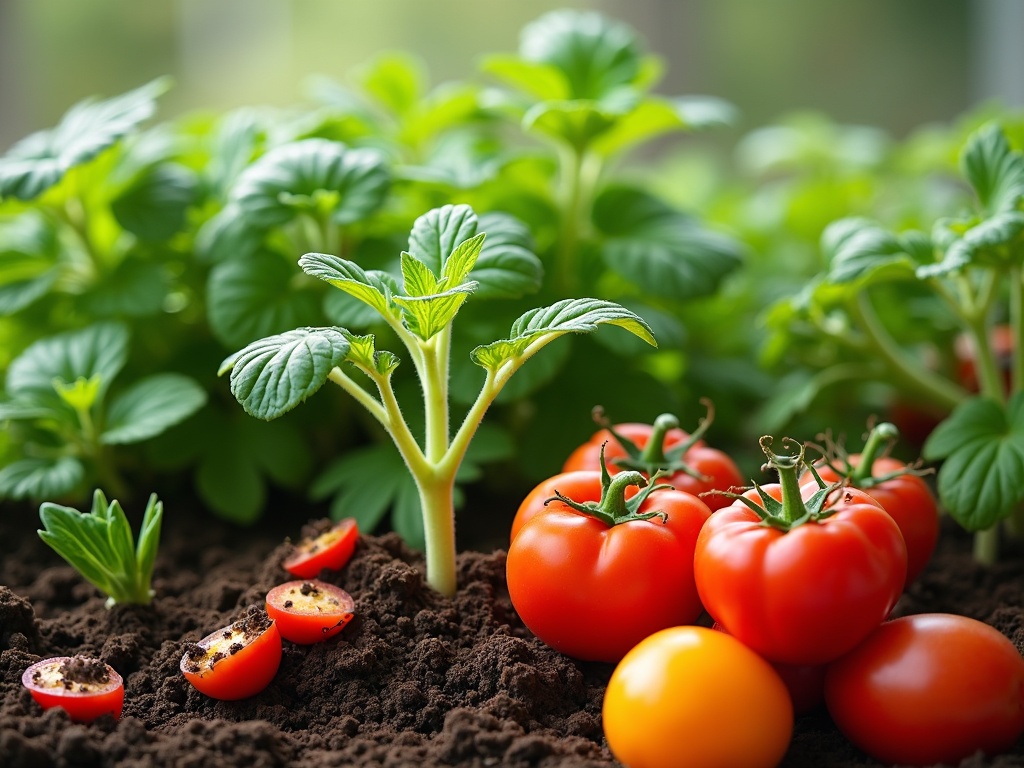The Beginner’s Bounty: Easiest Vegetables to Grow from Seed
Imagine stepping into your backyard and harvesting fresh, sun-ripened tomatoes, crisp lettuce, and flavorful herbs, all grown from tiny seeds you nurtured yourself. It sounds idyllic, doesn’t it? And it’s more achievable than you might think! Starting a vegetable garden from seed is a rewarding experience, offering a connection to nature, fresh produce, and a sense of accomplishment. Don’t be intimidated if you’re a beginner; plenty of vegetables are surprisingly easy to grow from seed, even if you don’t have a green thumb (yet!).
Why Start from Seed?
While buying transplants (young plants started elsewhere) offers a head start, sowing seeds directly into your garden or starting them indoors has several advantages:
- Cost-Effective: Seeds are significantly cheaper than transplants, allowing you to grow more for less.
- Variety: Seed catalogs offer a wider selection of varieties than what’s typically available at garden centers. You can find unique heirloom types and cultivars perfectly suited to your local climate.
- Timing Control: Starting seeds indoors gives you control over the growing season, allowing you to get a jump start on warm-weather crops or extend the season into the fall.
- Stronger Plants: Plants grown from seed often develop stronger root systems as they adapt to their environment from the very beginning.
- Sense of Accomplishment: There’s a special satisfaction in watching a tiny seed sprout and grow into a bountiful vegetable.
Top Easy Vegetables to Grow From Seed
Ready to dig in? Here are some of the easiest vegetables to grow from seed, perfect for beginner gardeners:
1. Radishes: The Speedy Sprout
Radishes are the ultimate fast-growing vegetable, often ready to harvest in just 3-4 weeks. Their quick turnaround makes them ideal for impatient gardeners and a great way to fill gaps in your garden beds. They don’t require much space and can even be grown in containers.
How to Grow: Sow seeds directly into well-drained soil in a sunny location. Plant seeds about ½ inch deep and 1 inch apart. Keep the soil consistently moist. Harvest when the radishes reach about 1 inch in diameter.
2. Lettuce: Salad Green Simplicity
Lettuce is a cool-season crop that’s easy to grow from seed, providing a continuous harvest of fresh salad greens. Choose from a variety of types, including loose-leaf, butterhead, and romaine.
How to Grow: Sow seeds directly into the garden in early spring or late summer. Plant seeds about ¼ inch deep and thin seedlings to 6-12 inches apart. Succession planting (sowing seeds every 2-3 weeks) will ensure a continuous supply of lettuce. Keep the soil moist and harvest leaves as needed.
3. Spinach: Nutrient-Packed and Prolific
Similar to lettuce, spinach is a cool-season crop that’s easy to grow from seed. It’s packed with nutrients and can be used in salads, smoothies, or cooked as a side dish.
How to Grow: Sow seeds directly into the garden in early spring or late summer. Plant seeds about ½ inch deep and thin seedlings to 2-4 inches apart. Keep the soil consistently moist and harvest leaves as needed. Spinach is prone to bolting (going to seed) in hot weather, so provide shade during the hottest part of the day.
4. Beans: Climbing or Bushy, Always Bountiful
Beans are relatively easy to grow from seed and come in a variety of types, including bush beans and pole beans. Bush beans are compact and don’t require staking, while pole beans climb and need a trellis or other support.
How to Grow: Sow seeds directly into the garden after the last frost. Plant seeds about 1 inch deep and 2-4 inches apart for bush beans, or 4-6 inches apart for pole beans. Provide a trellis or other support for pole beans. Keep the soil moist and harvest beans when they are young and tender.
5. Peas: Sweet and Satisfying
Peas are another cool-season crop that’s easy to grow from seed. They come in a variety of types, including shelling peas, snow peas, and snap peas.
How to Grow: Sow seeds directly into the garden in early spring. Plant seeds about 1 inch deep and 2-3 inches apart. Provide a trellis or other support for pea vines. Keep the soil moist and harvest peas when the pods are plump and tender.
6. Zucchini: The Abundant Producer
Zucchini is a summer squash that’s incredibly easy to grow from seed, sometimes to a fault – be prepared for a glut! It’s a prolific producer, so you’ll have plenty to share with friends and neighbors.
How to Grow: Sow seeds directly into the garden after the last frost. Plant seeds about 1 inch deep and 2-3 feet apart. Keep the soil moist and harvest zucchini when they are young and tender (6-8 inches long). Make sure your soil is well-draining. Poor drainage leads to rot and crop failure.
7. Cucumbers: Cool and Crisp
Cucumbers are a refreshing summer vegetable that’s easy to grow from seed. Choose from a variety of types, including slicing cucumbers, pickling cucumbers, and bush cucumbers.
How to Grow: Sow seeds directly into the garden after the last frost. Plant seeds about 1 inch deep and 12-18 inches apart. Provide a trellis or other support for vining cucumbers. Keep the soil moist and harvest cucumbers when they are the desired size.
8. Carrots: Sweet and Crunchy
Carrots can be a bit more challenging than some of the other vegetables on this list, but they are still relatively easy to grow from seed, especially if you choose the right variety and prepare the soil properly.
How to Grow: Sow seeds directly into the garden in early spring or late summer. Plant seeds about ¼ inch deep and thin seedlings to 2-3 inches apart. Carrots need loose, well-drained soil to grow properly. Avoid rocky or compacted soil, as this can lead to misshapen carrots. Keep the soil consistently moist and harvest carrots when they are the desired size.
9. Beets: Earthy and Versatile
Beets are easy to grow from seed and offer a double harvest – you can eat both the roots and the leaves. Choose from a variety of colors, including red, golden, and Chioggia (striped).
How to Grow: Sow seeds directly into the garden in early spring or late summer. Plant seeds about ½ inch deep and thin seedlings to 3-4 inches apart. Keep the soil moist and harvest beets when they are the desired size. You can harvest the leaves at any time.
10. Swiss Chard: Colorful and Nutritious
Swiss chard is a leafy green that’s easy to grow from seed and provides a continuous harvest throughout the growing season. It comes in a variety of colors, adding visual interest to your garden.
How to Grow: Sow seeds directly into the garden in early spring or late summer. Plant seeds about ½ inch deep and thin seedlings to 6-12 inches apart. Keep the soil moist and harvest leaves as needed. Like spinach, Swiss chard may bolt in hot weather, so provide shade during the hottest part of the day. Companion planting can also benefit your swiss chard by offering needed shading.
Tips for Success: Starting Seeds Like a Pro
Growing vegetables from seed is generally straightforward, but here are few tips to increase your chances of success:
- Choose the Right Seeds: Select seeds that are appropriate for your climate and growing conditions. Look for varieties that are known to be easy to grow and disease-resistant.
- Start with Good Soil: Use a high-quality seed-starting mix for starting seeds indoors. For direct sowing, amend your garden soil with compost or other organic matter to improve drainage and fertility.
- Provide Adequate Light: Seeds need light to germinate and grow. If starting seeds indoors, use grow lights or place them in a sunny window.
- Water Properly: Keep the soil consistently moist, but not waterlogged. Overwatering can lead to rot, while underwatering can cause seeds to dry out.
- Thin Seedlings: Once seedlings emerge, thin them to the appropriate spacing to prevent overcrowding.
- Harden Off Seedlings: Before transplanting seedlings outdoors, gradually acclimate them to the outdoor conditions by hardening them off. This involves exposing them to increasing amounts of sunlight and wind over a period of several days.
- Protect from Pests and Diseases: Monitor your plants regularly for pests and diseases. Take action promptly to prevent problems from spreading. Organic pest control methods are always best.
From Seed to Supper: Get Growing!
Growing your own vegetables from seed is a rewarding experience that connects you to nature, provides fresh produce, and saves you money. With a little planning and effort, you can enjoy a bountiful harvest of delicious vegetables all season long. So, grab a packet of seeds, get your hands dirty, and experience the joy of growing your own food!

